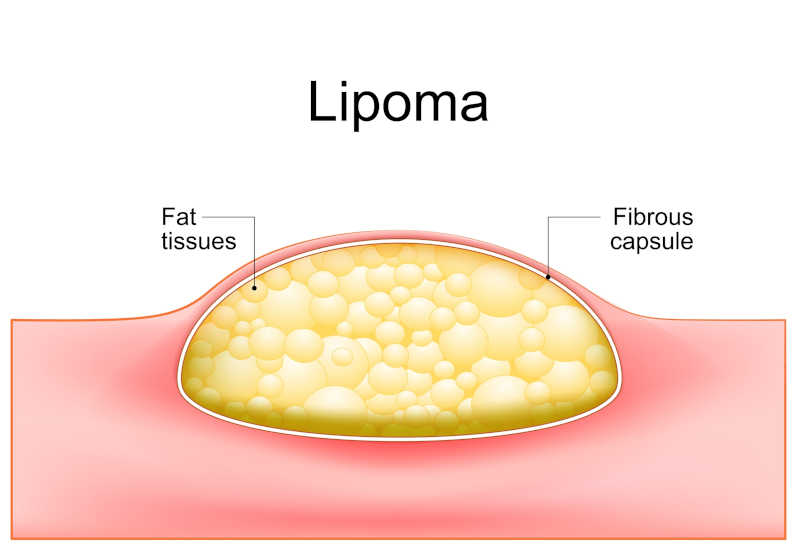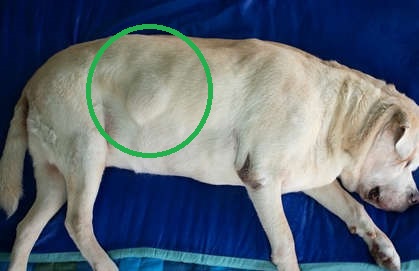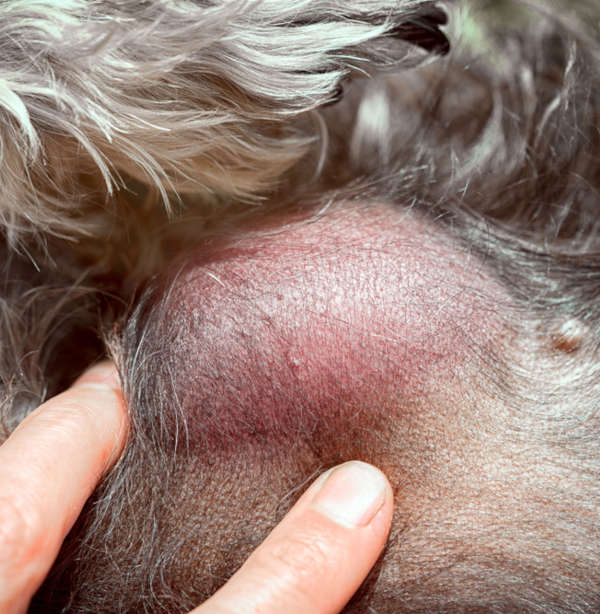
Lipomas in dogs are what we vets would consider good lumps. They may grow, but they don’t spread, and they generally don’t cause any problems. Generally. There are times that dog lipomas can grow big enough to cause problems or can grow in areas that create discomfort. It’s these cases that vets may consider removing a lipoma.
Overview of Lipoma in Dogs
Lipomas are common benign growths in dogs that often catch the attention of pet owners. These soft, encapsulated masses form under the skin and are generally slow-growing. While its natural to be concerned if you notice one, it’s important to recognize that lipomas are usually harmless and don’t necessarily require immediate medical intervention. However, following a proper diagnosis, monitoring their size and any changes in appearance is recommended.
Be sure to have all new or changing growths and lumps diagnosed by a veterinarian. Even if you’re certain the lump is a lipoma, it’s best to be safe.


[For more information and pictures, you can visit this link.]
Can a lipoma burst?
When a lump on a dog’s skin bursts, it’s because it’s filled with blood, pus, or decaying tissue and under pressure. None of these are the case in lipomas. They are not known to burst in the same way some other masses or skin issues might (for example, cysts can burst). Lipomas tend to remain comfortably contained within their capsule under the skin.
That being said, in some rare circumstances, a lipoma may become irritated, inflamed, and painful. This is usually after an injury or damage to the area, or if the lipoma is in an area of the body where it causes discomfort, such as the armpit. Under these remote circumstances, the damage or discomfort may be enough to lead to a wound or rupture of some kind that needs veterinary intervention immediately.

Even if a lipoma is suspected or diagnosed, it’s important to keep an eye on any changes in its appearance, as sudden alterations could indicate other issues that warrant veterinary attention.
Should I have a lipoma on my dog removed?
The decision about whether or not a lipoma should be removed, depends on a variety of factors. Your dog’s veterinarian will be able to help you decide if it’s a priority or not. Here are some reasons you might opt for removal:
- Size and discomfort: Large lipomas can press against muscles or organs, or even impede a joint’s ability to move naturally, leading to discomfort or mobility issues. Masses in inconvenient locations must be monitored closely, and should be removed before they get large enough to cause an issue.
- Rapid growth or change: If the lipoma starts growing quickly or undergoes visual changes, it might indicate an issue with the mass or the presence of something more malignant than a lipoma. In this case, removal is recommended as soon as possible.
- Concerns about malignancy: While lipomas are usually benign, it’s essential to rule out the concealed presence of malignancy through removal or biopsy, especially if they exhibit unusual characteristics.
- Risk of ulceration or infection: Lipomas that are prone to rubbing against surfaces, or that present with any kind of damage, might become ulcerated or infected. This warrants removal to prevent complications.
Distinguishing lipomas from other masses
While lipomas are sometimes easy to recognize, it’s also possible for a fat layer to develop over top of a more malignant type of mass., giving the appearance of a lipoma with something more sinister lurking.
There are also some non-malignant lumps and abnormalities that can mimic what one might think of as a lipoma. It’s important to differentiate between lipomas and these other abnormalities since they share some characteristics. Here are some examples:
- Cysts: Cysts are often softer than lipomas and can contain fluid. Unlike lipomas, cysts have the potential to burst when full and under pressure. When the cyst becomes over-filled, or bursts, it can cause discomfort and requires medical attention.
- Abscesses: Abscesses are painful, inflamed masses usually caused by infection. Some abscesses form deep under layers of skin, and appear at first as soft movable lumps. Abscesses are often painful though, and may be warm to the touch due to infection. Abscesses burst easily (and often) and require prompt veterinary care.
- Hematomas: Hematomas form as a result of injury or abnormality that causes bleeding under the skin. Hematomas on the ear flap are the most common, however they can appear just about anywhere as a result of trauma. They create a firm lump under the skin that may mimic the feeling of a lipoma, but they may be painful and often present with bruising too. Hematomas must be drained in order to heal properly, and it’s possible for large hematomas to rupture if left untreated. If a hematoma ruptures it will be very bloody, and there will likely be clots. This blood is from damaged blood vessels and immediate veterinary attention is necessary to avoid excessive blood loss.
When to Visit the Vet
While lipomas are generally harmless, it’s crucial to involve a veterinarian when you notice a new lump, and to work with your dog’s veterinarian to monitor for the following even after a diagnosis:
- If you notice rapid growth or significant changes in the lump’s appearance.
- If the lump causes discomfort, pain, or interferes with your dog’s mobility.
- If the lump becomes red, inflamed, or shows signs of infection.
- If your dog repeatedly licks, scratches, or bites the lump, as this could lead to ulceration.
Frequently Asked Questions
Is surgical removal of lipomas safe?
Surgical removal of lipomas is generally considered safe when the removal is uncomplicated and is performed by a skilled veterinarian. It’s a routine procedure, though lipomas that are larger require more intensive surgical work and carry slightly greater risk.
In older dogs, or dogs with other health conditions, your veterinarian will exercise caution when deciding how to anesthetize your dog to remove the lump.
What are the pootential complications of surgical removal?
While complications are rare, there’s a slight risk of infection or slow wound healing after removal. As with any surgery, there will be post-operative discomfort so giving pain medications as prescribed is necessary to keep your dog comfortable. Antibiotics may be prescribed too, if the location of the mass is at risk for contamination.
Risk of complications increases with larger masses or older animals, so monitoring the mass (and intervening before a problem exists) and maintaining your dog’s health are the best way to reduce risks.
Can lipomas reoccur after removal?
While uncommon, lipomas can occasionally reappear in the same place after removal. Most veterinarians take wide margins to reduce this risk when removing any kind of mass. Taking wide margins means they remove a reasonable amount of surrounding tissue (skin, fat, and muscle if necessary) to eliminate as much of the problematic tissue as possible.
Regular check-ups with a vet can catch any recurrence early.
Not all dogs will develop lipomas or other types of masses, however dogs who develop one lipoma are at increased risk to develop others. Removal of one lipoma does not prevent other lipomas from popping up elsewhere.
Can lipomas be cancerous in dogs?
Although extremely rare, liposarcomas are malignant forms of lipomas. This is why it’s so important to get a proper diagnosis of any lump on or under your dog’s skin.
Disclaimer: This website's content is not a substitute for veterinary care. Always consult with your veterinarian for healthcare decisions. Read More.



My six-year-old (60lbs.) Basset/Coon Hound mix had his Lipoma (1/2″ diameter) surgically removed from under his skin in the mid-lower abdominal area, only to start growing again in same spot about four months later. Now, about a year later it is about one-inch in diameter. At this point I’m debating if I should seek another veterinarian to perform the surgery as I suspect the prior vet didn’t perform the surgery thoroughly enough.
Hi there and thanks for your question. I’m sorry to hear that there is a lump where the old one was removed, I appreciate this must be concerning.
I’d want to know that the original lump was confirmed to be a lipoma by the lab. When completely removed, they shouldn’t grow back. However, if not all removed, they potentially can. This is more likely with very large and extensive lipomas.
It is also possible that this is something else (not a fatty lump) such as fluid build up or a cancer. I’d want the new lump examined, and possibly sampled, to determine what it is. We often won’t remove lipomas, unless they are very large or in an awkward location (like an armpit).
You can always seek out another vet if you’ve lost confidence in your current one, but this sort of thing can happen, even when all is done correctly.
“The information on this website is not a substitute for in-person veterinary care. Always seek advice from your veterinarian if you have concerns about your pet’s medical condition.”
My dog has a softball sized lipoma on the inner part of his back leg. He’s a large dog, Rhodesian Ridgeback weighing in at 130 lbs. Vet is worried with how large it is and his age (9) how the healing after surgery would go. I am worried it will keep getting bigger and bigger and mess with his gait and muscle structure if it hasn’t already. He is not a very active dog but wonder if he would be moreso if we removed it. He is unbothered by it. What would you do?
Hi there. I typically will suggest lipoma removal when they’re growing rapidly or in a place that could affect mobility (such as armpits or groins). If there’s concern for closure, consider consulting with a soft tissue surgeon. We would not want it to get to the point where is it causing the skin to stretch or ulcerate.
We do often leave lipomas where they are, but given this is fast growing, very large and potentially going to affect movement, it sounds like swift action is advised.
HI there, we have a senior dog (12yr) who has a large lump on her front right leg. The lump itself has grown from a very small lump to about the side of two golf balls over the course of 6 years. It has no pain, it does not affect her quality of life as she still goes on runs with us everyday and plays with her brothers as well as eats like no tomorrow. When we take her into the vet, they often question us about if she is actually 12 and not 6 years old. With that in mind, her lump has started to change color to a dark red color. We cannot operate on her as she has a grade 2 or 3 heart murmur and the risk of putting her under is larger. I’ve been researching into debulking of it, as this growth took 6 years to grow this large, and we have the understanding we may not have her for any longer than 5 years as it is since she is a pitbull boxer breed.
Amputating will destroy her quality of life, at this point we would be looking into simply reducing the risk of it ulcerating.
Is this something that is possible? outside of the risk of it growing back, are there any other risks we should consider? Can debulking be done under local anesthetic?
Hi there and thank you for your question. I’m sorry to hear about this.
There are a few things to unpick and go through here.
1) If a lump is bleeding, causing pain or becoming infected or ulcerated, we generally want to act quickly. Size alone is not necessarily a concern, but it can be if it is affecting mobility
2) A heart murmur (nor old age) is not a reason to not operate. It can increase the anaesthetic risk, but this would not mean an anaesthetic is out of the question. Indeed, many patients we operate on are old and/or have heart murmurs. We would potentially consider surgery in a patient like this, if we felt the lump was affecting quality of life
3) De-bulking is a surgery carried out under a full general anaesthetic. It is basically a vet removing as much of the lump as they can, but when it is not possible to remove the whole thing.
4) A first step to consider, which has not been mentioned, would be sampling the mass (a fine needle aspirate or biopsy), as this will help us make a plan. A mast cell tumour, for example, needs very wide margins.
Typically with this sort of patient, we’ll try to remove the mass or manage them palliatively with medicine such as pain relief and antibiotics as needed. For surgery, if the growth is very large or in a complex area, referral should be considered.
“The information on this website is not a substitute for in-person veterinary care. Always seek advice from your veterinarian if you have concerns about your pet’s medical condition.”